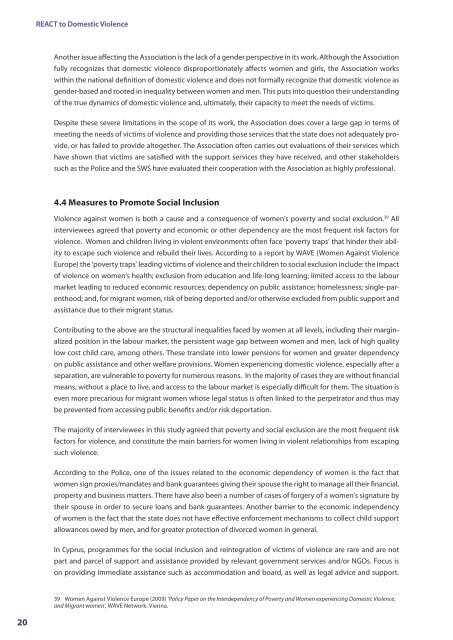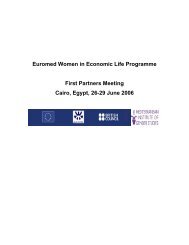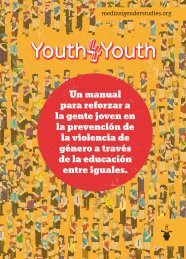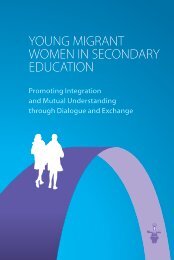react to domestic violence
react to domestic violence
react to domestic violence
Create successful ePaper yourself
Turn your PDF publications into a flip-book with our unique Google optimized e-Paper software.
REACT <strong>to</strong> Domestic Violence<br />
Another issue affecting the Association is the lack of a gender perspective in its work. Although the Association<br />
fully recognizes that <strong>domestic</strong> <strong>violence</strong> disproportionately affects women and girls, the Association works<br />
within the national definition of <strong>domestic</strong> <strong>violence</strong> and does not formally recognize that <strong>domestic</strong> <strong>violence</strong> as<br />
gender-based and rooted in inequality between women and men. This puts in<strong>to</strong> question their understanding<br />
of the true dynamics of <strong>domestic</strong> <strong>violence</strong> and, ultimately, their capacity <strong>to</strong> meet the needs of victims.<br />
Despite these severe limitations in the scope of its work, the Association does cover a large gap in terms of<br />
meeting the needs of victims of <strong>violence</strong> and providing those services that the state does not adequately provide,<br />
or has failed <strong>to</strong> provide al<strong>to</strong>gether. The Association often carries out evaluations of their services which<br />
have shown that victims are satisfied with the support services they have received, and other stakeholders<br />
such as the Police and the SWS have evaluated their cooperation with the Association as highly professional.<br />
4.4 Measures <strong>to</strong> Promote Social Inclusion<br />
Violence against women is both a cause and a consequence of women’s poverty and social exclusion. 39 All<br />
interviewees agreed that poverty and economic or other dependency are the most frequent risk fac<strong>to</strong>rs for<br />
<strong>violence</strong>. Women and children living in violent environments often face ‘poverty traps’ that hinder their ability<br />
<strong>to</strong> escape such <strong>violence</strong> and rebuild their lives. According <strong>to</strong> a report by WAVE (Women Against Violence<br />
Europe) the ‘poverty traps’ leading victims of <strong>violence</strong> and their children <strong>to</strong> social exclusion include: the impact<br />
of <strong>violence</strong> on women’s health; exclusion from education and life-long learning; limited access <strong>to</strong> the labour<br />
market leading <strong>to</strong> reduced economic resources; dependency on public assistance; homelessness; single-parenthood;<br />
and, for migrant women, risk of being deported and/or otherwise excluded from public support and<br />
assistance due <strong>to</strong> their migrant status.<br />
Contributing <strong>to</strong> the above are the structural inequalities faced by women at all levels, including their marginalized<br />
position in the labour market, the persistent wage gap between women and men, lack of high quality<br />
low cost child care, among others. These translate in<strong>to</strong> lower pensions for women and greater dependency<br />
on public assistance and other welfare provisions. Women experiencing <strong>domestic</strong> <strong>violence</strong>, especially after a<br />
separation, are vulnerable <strong>to</strong> poverty for numerous reasons. In the majority of cases they are without financial<br />
means, without a place <strong>to</strong> live, and access <strong>to</strong> the labour market is especially difficult for them. The situation is<br />
even more precarious for migrant women whose legal status is often linked <strong>to</strong> the perpetra<strong>to</strong>r and thus may<br />
be prevented from accessing public benefits and/or risk deportation.<br />
The majority of interviewees in this study agreed that poverty and social exclusion are the most frequent risk<br />
fac<strong>to</strong>rs for <strong>violence</strong>, and constitute the main barriers for women living in violent relationships from escaping<br />
such <strong>violence</strong>.<br />
According <strong>to</strong> the Police, one of the issues related <strong>to</strong> the economic dependency of women is the fact that<br />
women sign proxies/mandates and bank guarantees giving their spouse the right <strong>to</strong> manage all their financial,<br />
property and business matters. There have also been a number of cases of forgery of a women’s signature by<br />
their spouse in order <strong>to</strong> secure loans and bank guarantees. Another barrier <strong>to</strong> the economic independency<br />
of women is the fact that the state does not have effective enforcement mechanisms <strong>to</strong> collect child support<br />
allowances owed by men, and for greater protection of divorced women in general.<br />
In Cyprus, programmes for the social inclusion and reintegration of victims of <strong>violence</strong> are rare and are not<br />
part and parcel of support and assistance provided by relevant government services and/or NGOs. Focus is<br />
on providing immediate assistance such as accommodation and board, as well as legal advice and support.<br />
39 Women Against Violence Europe (2009) ‘Policy Paper on the Interdependency of Poverty and Women experiencing Domestic Violence,<br />
and Migrant women’, WAVE Network. Vienna.<br />
20







